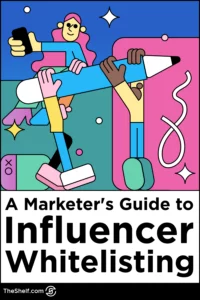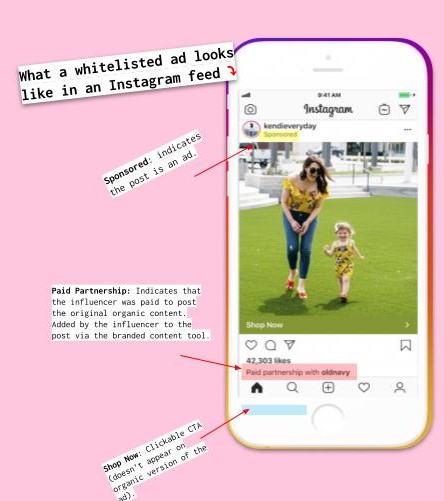You may have heard influencer allowlisting is a hot topic in the influencer marketing world, but what exactly is it? How do you know if allowlisting is the right influencer marketing strategy for your next campaign? And what social media channels work best for allowlisting content?
Don’t worry, I had lots of questions too. But we’ve got you covered. Here at The Shelf, we’ve done a deep dive on all things influencer allowlisting so you don’t have to. In the following post, we’ll give you all the deets on what it is, how and when you should use it in your influencer campaigns, some insights into our allowlisting results, and more!
Ready to take your influencer marketing to the next level? Let’s dive in.
What is Influencer Allowlisting/Whitelisting?

First and foremost, let’s define our terms. Allowlisting (formerly whitelisting) is a campaign optimization strategy that allows you to turn organic influencer posts into paid ads. The important thing to note about these paid posts is that they are run through the influencer’s account – not your brand account. (This differentiates allowlisting from dark posts, but more on that later.)
By creating paid ads from an influencer’s organic posts, you can increase the reach of your sponsored content. AND you’re able to target your desired audience more accurately.
Allowlisting influencer content also allows you to make each post in your campaign more shoppable. Clickable CTA buttons are added to each allowlisted post with trackable URLs. That means you can add a “Shop now” or “Learn more” button to content and track exactly how many viewers convert from that post.
You may already be aware that social commerce are becoming more and more important to your influencer marketing campaign. Experts project the global market for social commerce will reach $2.9 trillion by 2026 (yes, that’s trillion with a “T”), so it’s time to allowlist that influencer content and get that bread. 🍞
Benefits of Allowlisting Content in Your Influencer Campaigns
If you want to see results on your influencer marketing campaigns, allowlisting is the way to go. Influencer allowlisting is one of the primary ways to prime the path for conversions and sales with your influencer content.
Plus, it’s a win-win for your brand and your influencers since allowlisted influencer content is amplified to wider audiences, giving both the influencer and your product more exposure. More eyeballs on your products mean more opportunities for people to click and buy. And on allowlisted ads, getting to your brand’s website is as easy as clicking the in-post CTA button. Easy peasy!
When you prioritize allowlisting as part of your influencer marketing strategy, you can reach new audiences, find customers you didn’t know you had, and specifically target audiences that would otherwise be unavailable to you.
Influencer allowlisting allows you to:
- Drive clicks through CTA buttons
- Run ads at scale (up to 40 per campaign!)
- Review comprehensive insight reporting
- Optimize in real-time with the lowest CPM
- Edit influencer content before putting dollars behind it
- Target audiences precisely based on your campaign objective
- Leverage different social media platforms in the same campaign
One of the benefits of allowlisting influencer content is that you have the ability to make edits and tweaks before putting any money behind a post. Take this allowlisted Instagram story from quip for example.
Influencer @luciebfink created a story post for quip’s special edition red toothbrush with the text, “Volume up ✨ to hear what this incredible special edition @getquip will do @red.” (Sidenote: quip has since moved their Instagram account to @quip if you’re reading this and thinking I do need a new toothbrush.)
Quip decided to allowlist the content but made a copy edit to better fit their campaign objective, highlighting their partnership with @red. The new copy read, “@getquip has an amazing new partnership with @red.” This slight edit allowed them to make the brand’s handle center stage in the post and better illuminate the @red partnership.
Tweaks like these allow an even more symbiotic relationship with influencers. Your creators get to create content that serves their followers and you have the ability to make small changes so the language better speaks to your audience within their following.
Of course, always be sure to outline editing permissions and parameters with your influencers before launching a allowlisting campaign. You’ll want to make sure your influencers feel comfortable and confident in the content that lives under their handle and on their page.
Allowlisting vs Dark Posts vs Boosting
Of course, allowlisting isn’t the only paid optimization strategy. You’ve probably heard of boosting and dark posts. These are good strategies too, but they offer different benefits and parameters than allowlisting. Let’s get into it.
Dark Posts
Dark posts are basically social ads for your brand. You can run them on any social channel and they can be created with brand-produced assets or influencer-produced assets. Unlike boosted, organic, and allowlisted content, they don’t show up on your (or your influencer’s) timeline or organically in your follower’s feeds.
These ads show up as sponsored content to audiences you are specifically targeting. You run these ads through your brand account (not the influencer’s account) and they can be used to compliment boosted or allowlisted posts.
Boosting
Boosting is also known as the handshake tool. It allows influencers to tag your brand using the Branded Content Tool. From there, you can boost the post from the backend of your ads manager. You can also boost posts from your brand account. You can boost an individual post on Facebook or Instagram and “promote” individual videos on TikTok.
Unlike allowlisting, each post must be boosted individually. This makes it harder to scale boosted content on a campaign level. Boosted content is great if you want to highlight a specific piece of content or target different audiences with each post.
How to Allowlist on Instagram
Know your platform. Whether you’re using an agency or allowlisting through influencers’ individual pages, your influencers will need to activate their business accounts on both Instagram and Facebook (especially if you intend to allowlist cross-platform). This will allow you to track engagement and complete any necessary (and agreed upon) content edits.
When building a allowlisting campaign on Instagram, think in terms of scalability. Creating content designed for feed posts is one of the most effective ways to ensure content is scalable. Square posts with a 1:1 ratio and vertical posts with a 4:5 ratio work best. Images of these sizes can be repurposed in an Instagram story, Facebook post, or Facebook story.
Going the reels route? Try to make your video compatible with both Instagram and TikTok viewing so you can get the most mileage out of a single post.
Looking for an Instagram refresher? Check out our Instagram influencer marketing tips and tricks.

How to Allowlist on Facebook
If you decide not to partner with an agency or allowlisting platform, you’ll need to go the manual allowlisting route. The first step is to gain access to your influencer’s Facebook Business Manager. Once those permissions are shared, you will be able to access the influencer’s Facebook and Instagram accounts through your brand’s Facebook Ads Manager. From there you will grant your influencer permission to “Create ads” for your brand.
Similar rules apply when it comes to allowlisting under the umbrella of Meta apps. Create content for scalability. Choose influencers you trust. And allow creativity to flow so the paid media doesn’t feel like an ad.
How to Allowlist on TikTok
Creativity is king.
Our Director of Digital Strategy, Anton Nestel, likes to say TikTok is the Super Bowl of influencer marketing – and for good reason. TikTok allows creators and influencers to let their creativity run wild, and it shows in engagement.
Allowlisting is all about repurposing influencer-generated content. The magic of allowlisting is that it makes paid media feel organic. The thing about modern social media users, and especially TikTok scrollers, is that they don’t mind seeing branded content, but they don’t want to see ads. At least not in the traditional sense. Allowlisting influencer content can allow your brand to land in the sweet spot of getting the most bang for your buck and not putting off viewers.
Finding influencers you trust on TikTok, whose audiences align with yours is one of the best ways to spend your allowlisting budget. The trick is to allow your influencers to create the content in the way they want to. (That’s why choosing the right influencers is so important.) Embrace paying for content that feels organic to your audience.
The proof is in the pudding. We’ve been getting some pretty exciting engagement stats back from our clients’ allowlisted influencer content. We’re talking as much as 12 percent engagement on allowlisted TikTok posts (compared to — still respectable — 2 percent engagement on other platforms).
Influencer Allowlisting Best Practices
Now that you know a bit about the benefits of allowlisting influencer content, it’s time to start building your next campaign. When it comes to influencer marketing best practices, we’ve got you covered. Here are our top tips when looking to reach your target audience with allowlisted influencer-generated content.
1. Encourage creativity.
Let your influencers unleash their creativity. Of course, you want their posts to fit your brand and the objective of the campaign, but try your best not to stifle their creativity. Allowlisted influencer content gets the most engagement when it still feels authentic and organic.
2. Don’t let a small budget deter you.
The good news is you don’t have to have a huge budget to have a pretty decent impact with your allowlisting. We recommend you set aside at least 10 percent of your campaign budget for allowlisting. Here at The Shelf, we use the creator platform Lumanu to allowlist our customers’ campaigns.
If you’re a small or medium-sized brand, that isn’t working with the right influencer marketing agency (like The Shelf), don’t fret. Allowlisting will deliver results even if you don’t have a lot to spend.
3. Choose the right influencers.
Select a few creators you trust and have a consistent relationship with. We recommend focusing on a few special influencers who have more of an ambassadorial role with your brand. Invest a couple hundred dollars in each influencers’ content for the campaign. Then you can run the allowlisted content directly through their page.
4. Extend the shelf life of your influencer marketing campaign.
Take a look at the scope of your campaign. In a traditional ad group, you’d want at least two to three ads up and running at a time. The same principle applies here. Wait to start your influencer allowlisting until two or three posts are live. Take the time to assess engagement and make any necessary tweaks before rolling out the rest of the campaign.
Once you’ve given the first few posts the chance to simmer, go ahead and start allowlisting that content and any future content that is part of the campaign. A good rule of thumb is to continue allowlisting on a campaign until two weeks after the last piece of content is posted. This allows the content to have as much time to run as possible.
5. Allowlist as much content as possible.
When it comes to influencer allowlisting, more is more. We’ve found that the top-performing organic posts don’t always align with the top-performing paid posts (even when those paid posts feel organic). So the age-old advice of putting dollars behind your best-performing content doesn’t work as well here.
We recommend influencer allowlisting as much content as possible and letting the results speak for themselves. And hey, with the capacity to allowlist as many as 40 posts per campaign, why wouldn’t you take advantage of that reach?
6. Know your rights.
When working directly from an influencer’s business account, it’s more important than ever to know your content rights. Make sure you establish the following with your influencers upfront:
- Content ownership
- Guidelines for reuse
- Payment terms and fees
- Duration of the campaign
- All channels used in the campaign
- Modification permissions (including edits)
- How your brand can repurpose the content
- Content posting schedule and requirements
- Any restrictions or exclusivity for influencer social activity
Conclusion: Make the Most of Your Influencer Marketing Campaigns with The Shelf
All that is to say, influencer allowlisting is a pretty rad optimization strategy for influencer marketing campaigns. It allows you to grow your audience, strengthen relationships with your best influencers, and increase engagement across multiple platforms at once.
Looking for more influencer marketing tactics or help influencer allowlisting your next influencer campaign? We’ve put together thousands of successful social media strategies for EPIC influencer campaigns for brands just like yours. We’d love to make your allowlisting dreams a reality. Click below to schedule a demo.







